

Inertia Tower for Students Who Are Blind or Visually Impaired. This hands-on activity is an excellent introduction to Newton’s First Law, otherwise known as the Law of Inertia.
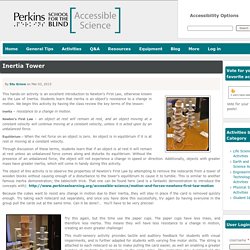
Students learn that inertia is an object’s resistance to a change in motion. We begin this activity by having the class review the key terms of the lesson: Inertia – resistance to a change in motion. Newton’s First Law – an object at rest will remain at rest, and an object moving at a constant velocity will continue moving at a constant velocity, unless it is acted upon by an unbalanced force.
Equilibrium – When the net force on an object is zero. Through discussion of these terms, students learn that if an object is at rest it will remain at rest unless an unbalanced force comes along and disturbs its equilibrium. 5 E Learning Cycle Balloon Rocket Lesson by Lynda R Williams. Newton's Laws of Motion and Forces. Newton's 3 Laws, with a bicycle - Joshua Manley. Egg Drop - Sick Science! #115.
Newton's Three Laws of Motion. How Newton's Laws of Motion Work. Next to E = mc², F = ma is the most famous equation in all of physics.
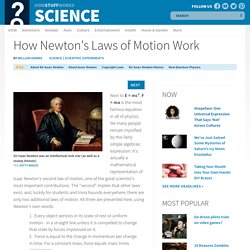
Yet many people remain mystified by this fairly simple algebraic expression. UnBoxed: online. Alicia Crump, 6th Grade Engineering High Tech Middle Chula Vista download pdf Everyone loves a good carnival, especially the rides!
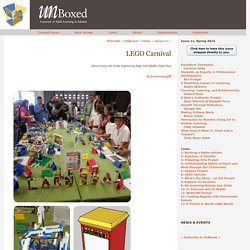
In addition to adrenaline, fun, and excitement, carnival rides provide us a perfect example of simple machines in action. In this project, students combined their understanding of simple machines, motorized mechanisms, LEGO construction, 3D modeling, and engineering design thinking to create their own LEGO Carnival. Sixth grade Lesson Force and Motion Essential Questions. Essential questions are a great strategy to help middle school students make connections between big ideas in science, their own lives and the learning objectives investigated in class.

Choosing the right essential questions can frame an entire unit in a way that engages student curiosity. The nature of science is based on the assumption that science addresses questions about the natural and material world. The scientific way of knowing brings new knowledge that can, in turn, describe the consequences of actions which humans may use to solve (or create) problems. In this activity, students explore three essential questions related to Inquiry and Forces and Motion: Newton's Mini Labs Final. Introducing Newton's Laws with Learning Cycles / Labs, Activities, and Other CoolStuff. As many of you know, the Learning Cycle is an approach to science instruction developed by Atkin and Karplus in 1962 while working on the SCIS (Science Curriculum Improvement Study) project.
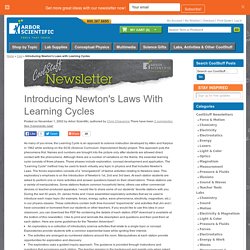
This approach puts the phenomena first. Names and numbers are brought into the picture only after students are allowed direct contact with the phenomena. Although there are a number of variations on the theme, the essential learning cycle consists of three phases. These phases include exploration, concept development and application. Newton's Three Laws of Motion: Introduction. Newton's First Law - Complete Toolkit. Newton's First Law - Complete Toolkit Objectives.
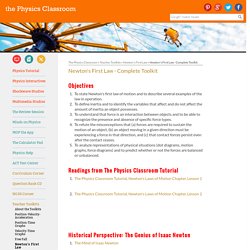
Rube Goldberg Machines. Makerspaces. Designing Teaching and Learning Tools. Designing teaching and learning tools is something we do every day at the Exploratorium when we create our own exhibits in our on-site workshop.
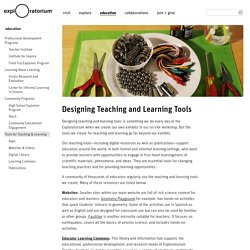
But the tools we create for teaching and learning go far beyond our exhibits. Our teaching tools—including digital resources as well as publications—support educators around the world, in both formal and informal learning settings, who want to provide learners with opportunities to engage in first-hand investigations of scientific materials, phenomena, and ideas. They are essential tools for changing teaching practices and for providing learning opportunities. A community of thousands of educators regularly use the teaching and learning tools we create.
Many of these resources are listed below. Websites: Smaller sites within our main website are full of rich science content for educators and learners. Education, Research, Innovation. Laws of Motion. Wonderville Games, Science Alberta Foundation. Rube Goldberg Project Overview. Capture the Learning: Crafting the Maker Mindset. You've heard some good stuff about the maker movement such as how making helps students learn through embodied cognition, creates a mindset that's empowering, and builds creative confidence.

You're interested in crafting some maker lessons but don't know where to start or how to do something that works in your classroom. Or perhaps you're worried that you don't have time to do a long, involved project. How do you still teach the Common Core or cover the required curriculum? These simple steps will get you started. Teaching Creativity? First, identify the content you need to teach. Second, think about the skills that you want students to use and practice.
Third, think about restrictions or limitations for the project. Fourth, craft a main question, the simpler the better. The Power of Design Thinking Capture the learning. Project Hints and Teacher Tips. Your own imagination and creativity are all you need to build a super Rube Goldberg machine.
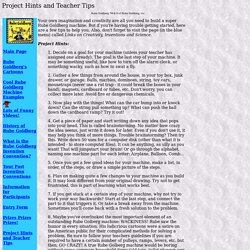
But if you're having trouble getting started, here are a few tips to help you. Also, don't forget to visit the page (in the blue menu) called Links on Creativity, Inventions and Science. Project Hints: 1. Decide on a goal for your machine (unless your teacher has assigned one already). 2. 3. Rube Goldberg Butts In. “Rube Goldberg is the guy who figured out how to get from point A to point B using all the letters in the alphabet.” – Art Spiegelman Rube Goldberg started out commenting on the world and ended up changing it.
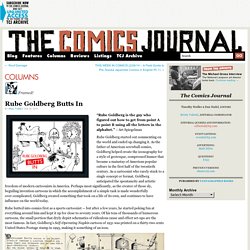
As the father of American screwball comics, Goldberg helped create the iconography for a style of grotesque, compressed humor that became a mainstay of American popular culture in the first half of the twentieth century. Middle School And High School Science Lesson - Rube Goldberg Contraptions.